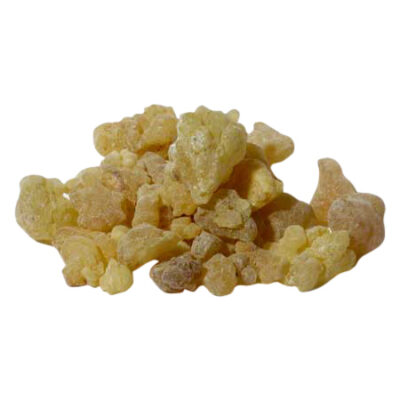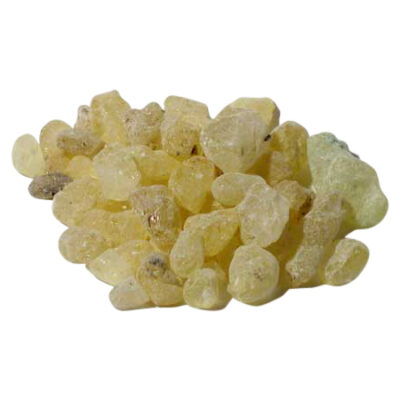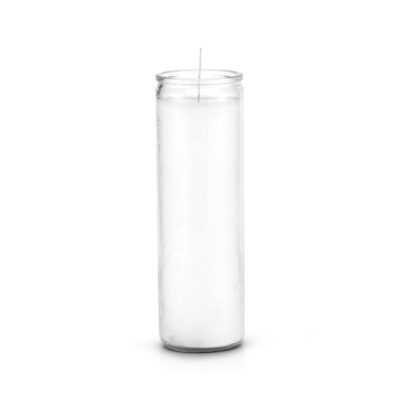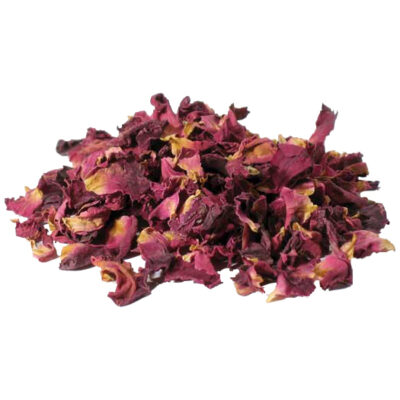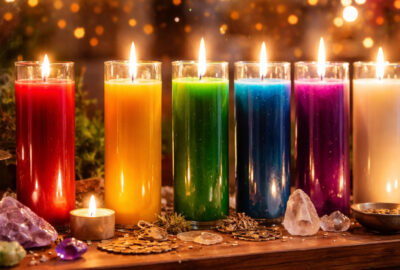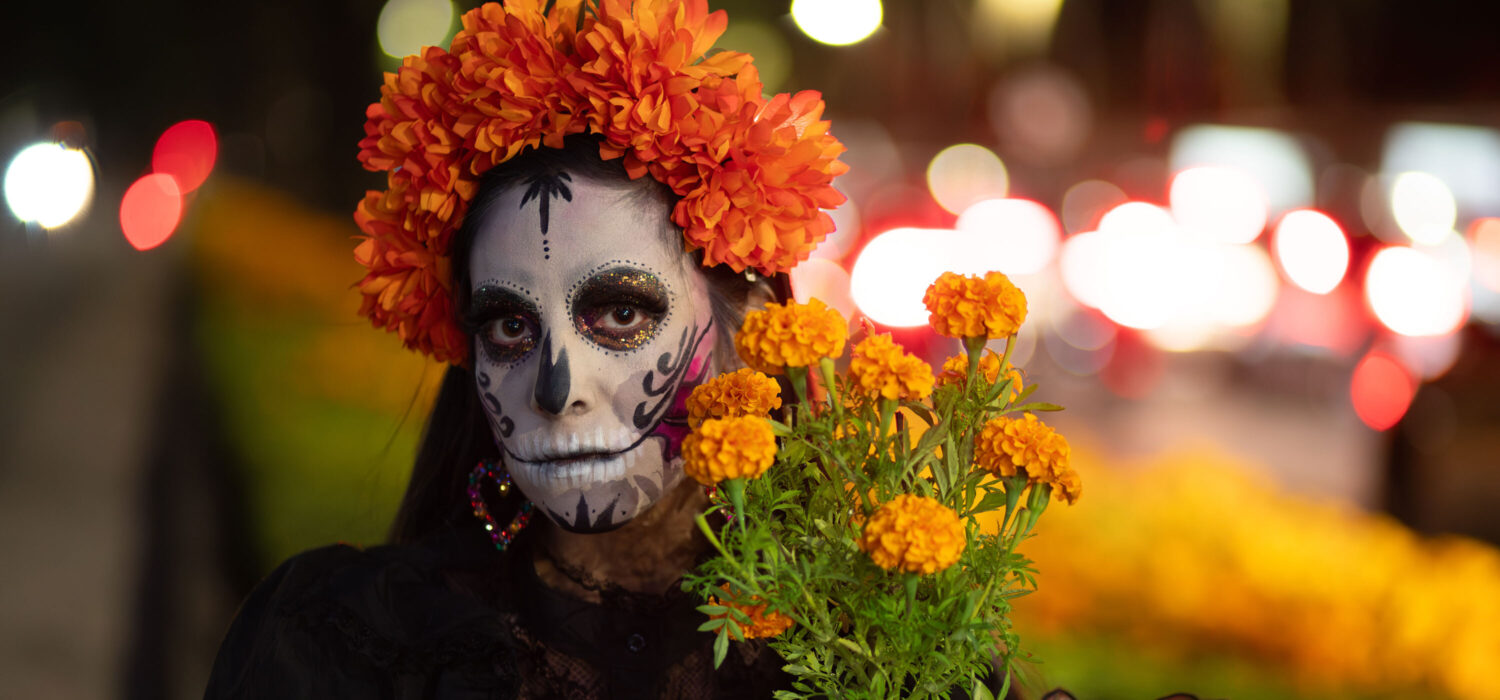
Day of the Dead vs All Saints’ Day: Meaning, Traditions, and How They Honor the Dead
As autumn deepens and the veil between worlds grows thin, cultures across the globe turn toward remembrance. From solemn candlelight to joyful celebration, this is the season to honor those who have crossed into spirit.
In many homes, families observe All Saints’ Day, All Souls’ Day, and Día de los Muertos: three observances that share the same early November window but express remembrance in unique ways.
All Saints’ Day and All Souls’ Day are rooted in Catholic faith, honoring saints, martyrs, and the faithful departed through prayer and reflection. Día de los Muertos, or Day of the Dead, is born of Indigenous Mesoamerican tradition, later merging with Catholic beliefs to form a celebration filled with light, color, and ancestral love.
Though these sacred days differ in form, they share a single purpose: to celebrate life, honor the dead, and keep the eternal bond of love alive.
Across many faiths and cultures, this time of year marks the turning of the seasons and the thinning of the veil between worlds. In Celtic lands, it is mirrored in Samhain, when the dead are remembered through firelight and offerings. In East Asia, it echoes through the Hungry Ghost Festival, a time of feeding and honoring wandering spirits. These observances, though born in different lands, share a single truth: that remembrance bridges time and space, and love continues long after death.
The Origins of All Saints’ Day and Día de los Muertos
The history of All Saints’ Day begins in early Christianity. By the fourth century, the Church dedicated special feast days to honor martyrs who had died for their faith. As the number of saints grew, the Church established one universal feast day for all of them.
In 609 CE, the Pantheon in Rome was consecrated as a church to all holy martyrs, marking the early foundation of All Saints’ Day. By 837 CE, Pope Gregory IV declared November 1 a day to honor all saints, known and unknown. The following day became All Souls’ Day, a time to pray for the faithful departed who were believed to be in purgatory, preparing for eternal rest.
Early Christians viewed martyrdom as a sacred pathway to holiness, gathering annually at the tombs of saints to pray and share communion. Over time, these local feast days grew into a single universal day to honor all who had reached eternal life.
In ancient Mexico, archaeologists have traced ancestor ceremonies back more than 3,000 years. The Aztecs revered the goddess Mictecacihuatl, the Lady of the Dead, who ruled over the afterlife and presided over rituals filled with offerings of maize, cacao, and flowers. These early practices, centered on gratitude and the continuity of life, shaped many of the traditions that remain in Día de los Muertos today.
Long before European influence reached the Americas, the Aztec and other Indigenous peoples of Mexico celebrated ancestral festivals dedicated to honoring the dead. These celebrations included food, flowers, and offerings meant to guide the spirits of loved ones back home. When Catholic feast days were introduced, Indigenous and Christian traditions blended, forming the powerful and vibrant celebration known as Día de los Muertos.
This blending of faith and folklore teaches a timeless truth shared across cultures: death is not an end but a sacred transformation.
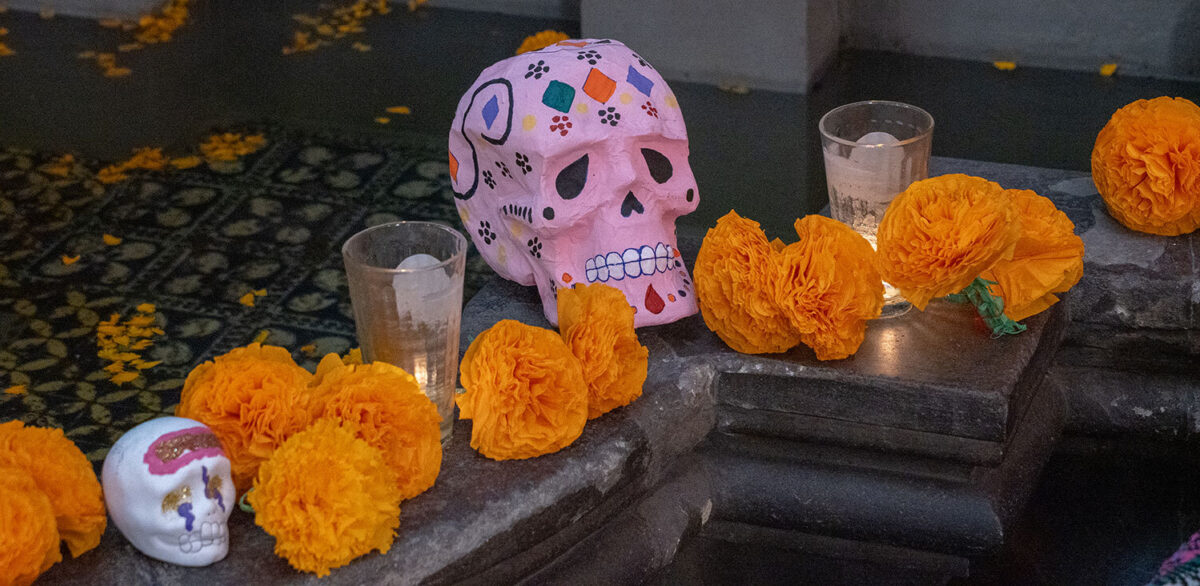
A pink sugar skull surrounded by marigolds and candles during a Day of the Dead celebration in Mexico.
Who Is Honored on All Saints’ Day, All Souls’ Day, and Día de los Muertos
The first two days of November each hold a special purpose in both Catholic and Latin American traditions.
November 1: All Saints’ Day and Día de los Inocentes (Day of the Little Angels)
In Catholic tradition, November 1 honors all saints and martyrs who have attained heaven. In Mexico and much of Latin America, this day also welcomes the spirits of departed children (angelitos, or “little angels”) with offerings of toys, sweets, and prayers of remembrance.
November 2: All Souls’ Day and Día de los Muertos (Day of the Dead)
Catholics dedicate this day to praying for all departed souls, especially those still journeying toward divine peace. In the Día de los Muertos tradition, families believe that the spirits of adult loved ones return home to visit, nourished by candles, marigolds, and the love expressed through food and music.
Each day reflects humanity’s shared desire to honor life’s sacred cycle and to maintain connection with those who came before us.
Together, these three days form a sacred continuum of remembrance. All Saints’ Day turns our hearts to those who achieved divine grace, All Souls’ Day calls us to pray for every soul on its journey home, and Día de los Muertos invites us to celebrate that journey with color, song, and love. In this way, heaven, earth, and ancestry are woven together in one sacred circle.
Traditions and Rituals of Remembrance
All Saints’ Day and All Souls’ Day are marked with reverence and quiet devotion. Families attend mass, light white or gold candles, and visit cemeteries to leave flowers and prayers for their ancestors. These acts of remembrance remind the living of faith, humility, and gratitude.
Día de los Muertos, by contrast, bursts with life and color. Families create ofrendas—altars adorned with marigolds, candles, sugar skulls, and favorite foods of departed loved ones. The scent of copal incense fills the air, believed to purify the space and guide spirits home. Traditional foods such as pan de muerto and candied pumpkin are shared with joy, symbolizing the unity of life and death.
Each symbol carries deep meaning: marigolds, known as cempasúchil, guide the spirits home with their bright color and scent; sugar skulls honor individuality and joy; and pan de muerto, often baked in the shape of bones, reminds us that from death springs life renewed.
To embrace these sacred practices at home, consider creating your own remembrance altar. Include 7-Day Saint Candles in white, gold, or purple, Frankincense and Myrrh incense to purify the space, and fresh flowers such as marigolds or roses to honor your ancestors. Adding photos, offerings of food, or personal mementos deepens your spiritual connection. Building a home altar for protection and prayer is a meaningful way to invite peace and remembrance into your space.
Around the world, similar customs of remembrance unfold at this same time. In France, families celebrate La Toussaint by adorning graves with chrysanthemums, flowers that represent immortality. In the Philippines, Araw ng mga Patay brings entire families together to clean and decorate tombs, share food, and spend the night near their loved ones’ resting places. These acts, like the lighting of candles and creation of altars, express a universal desire to keep connection alive across generations.

Pan de muerto surrounded by glowing candles and vibrant marigolds on a Day of the Dead altar.
The Shared Message of All Saints’ Day and Day of the Dead
Though their expressions differ, both traditions remind us that life is precious and sacred.
For Catholics, All Saints’ and All Souls’ Days are a call to reflection and faith. For those observing Día de los Muertos, the focus is on celebration and honoring life through music, food, and laughter. In both, light plays a central role. Candles in churches and on altars symbolize the eternal soul, bridging the realms of the living and the departed. Lighting candles for those who have passed remains one of the most powerful acts of remembrance.
Together, these observances teach us to see death not as an ending, but as part of the eternal flow of spirit and love.
How to Create a Combined Altar for Saints and Ancestors
If you wish to honor both traditions, you can create a blended altar that unites prayer and celebration. This sacred space honors saints, ancestors, and all beloved souls who continue to guide and protect you.
You will need:
- White candles and gold candles for light and faith
- Marigolds or roses for renewal and remembrance
- Copal or Frankincense incense for spiritual purification
- Photos or relics of saints and loved ones
- Offerings of bread, fruit, or sweets
- A bowl of water for cleansing and reflection
Choose a quiet corner of your home for your altar, ideally facing east, symbolizing renewal and divine light. Begin your ritual at dusk, when the balance of day and night mirrors the connection between worlds. You may sprinkle holy water or Florida Water for cleansing and blessing, or add a Saint Michael candle to invite protection and strength as you open this sacred space.
To begin, cleanse your space with incense. Arrange your altar thoughtfully, placing flowers, candles, and offerings in a way that feels sacred to you. As you light each candle, speak the names of your loved ones and saints, thanking them for their love and guidance. Sit quietly, allowing yourself to feel their presence. When you are ready, close your ritual with gratitude, knowing that the light of remembrance continues to shine.
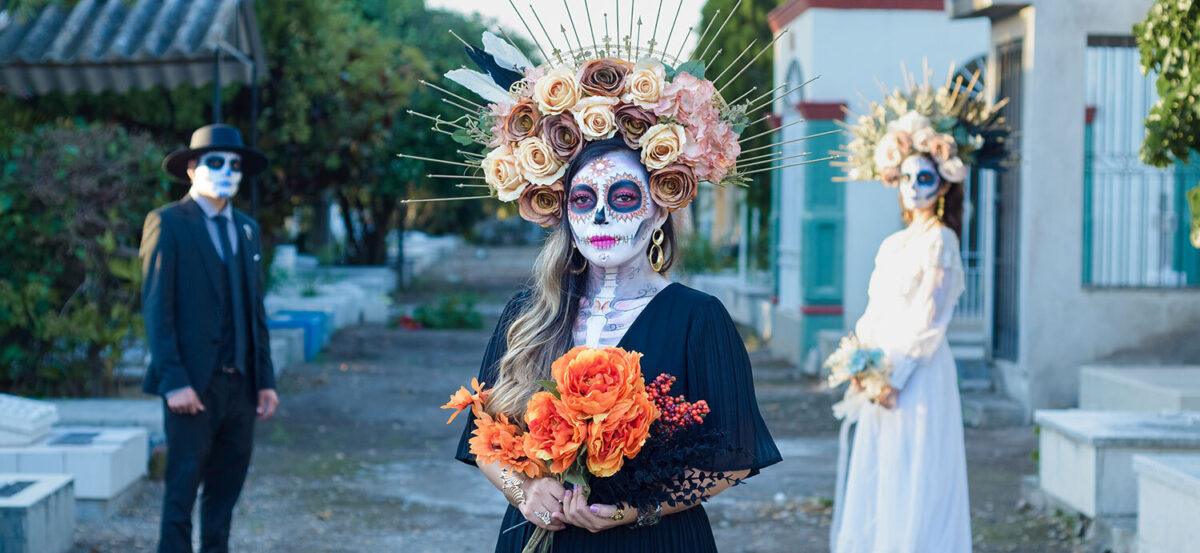
La Catrina and El Catrín, the elegantly dressed skeleton figures of Día de los Muertos, symbolize the unity of life and death during Mexico’s celebrations.
The Universal Meaning of Honoring the Dead
Whether celebrated with prayer or pageantry, All Saints’ Day and the Day of the Dead share the same sacred message. They remind us to cherish life, honor those who came before us, and recognize the eternal bond between body and spirit.
Both traditions inspire acts of remembrance: lighting candles, offering flowers, and speaking names aloud. These gestures are love made visible. They remind us that even though death touches everyone, the soul’s journey continues and the heart’s connection never fades.
Common Questions About All Saints’ Day and Día de los Muertos
Is the Day of the Dead the same as All Saints’ Day?
No. They share dates and similar themes but differ in focus. All Saints’ Day honors canonized saints and martyrs, while Día de los Muertos celebrates the return of loved ones’ spirits.
Why do they fall on November 1 and 2?
Catholic holy days were established on these dates and later merged with Indigenous festivals that honored ancestors, creating a season of remembrance.
Can anyone observe these traditions?
Yes. Anyone can honor their loved ones with candles, prayers, and offerings. These days are about remembrance and respect, not religious boundaries.
What colors and symbols are used?
All Saints’ Day uses white, gold, and purple for purity and faith. Día de los Muertos is filled with vibrant colors, especially orange marigolds, symbolizing the warmth of the sun and the return of the spirits.
Why are candles and marigolds important?
Candles symbolize eternal light, guiding souls back to their families. Marigolds, known as cempasúchil, represent the beauty of life and the power of memory.
Can I celebrate both All Saints’ Day and Day of the Dead together?
Yes. Many families blend these observances, lighting candles for saints while offering flowers and food for ancestors. This creates a spiritual bridge between faith and family tradition.
What prayers can I offer for the departed?
Simple prayers of gratitude are perfect. Many recite the Beatitudes or speak directly from the heart, asking for peace and guidance for loved ones who have crossed over.
Which saints are connected to remembrance?
Saint Michael the Archangel is called upon for protection, Saint Gertrude for souls in purgatory, and Saint Joseph for peaceful passing and remembrance.
Keeping the Light of Remembrance Alive
As autumn fades and the year turns inward, these sacred observances remind us that love endures beyond time. Whether through quiet prayer or festive altars, honoring the dead brings peace to the living.
Light your candles, prepare your altar, and speak the names of those you love. The spirits of your ancestors walk beside you, carried on the scent of incense and the glow of remembrance.
As the final leaves fall and the nights grow longer, these observances invite us to reflect on our own place in the great circle of life. Every act of remembrance - a whispered name, a lit candle, a shared story - nourishes the bond between worlds. In honoring those who came before, we also awaken gratitude for the life and love we carry forward.

